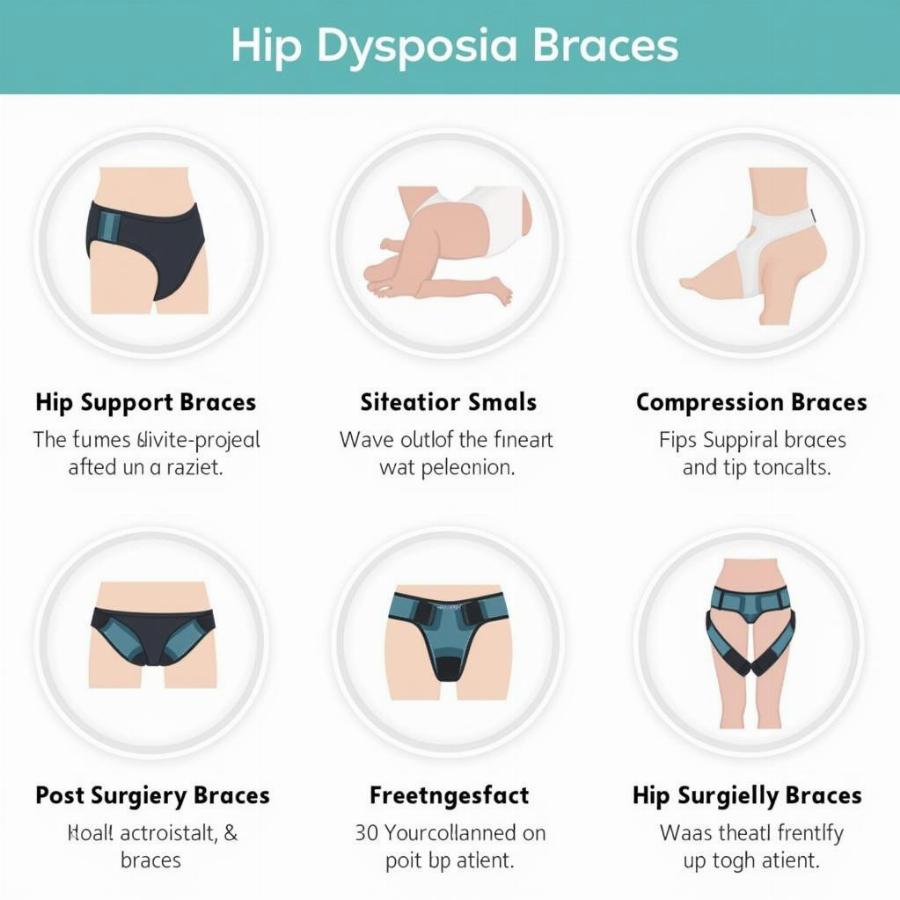Hip dysplasia is a common and often debilitating condition affecting many dogs, particularly larger breeds. A hip dysplasia brace dog can significantly improve a dog’s quality of life by providing support, stability, and pain relief. This article will delve into the world of hip dysplasia braces for dogs, covering everything from understanding the condition to choosing the right brace and ensuring its proper use.
Understanding Canine Hip Dysplasia and the Role of Braces
Canine hip dysplasia is a genetic condition where the hip joint doesn’t develop correctly. This leads to instability, looseness, and eventually, painful arthritis. The ball and socket of the hip joint don’t fit snugly together, causing grinding and wear. While surgery is sometimes necessary, conservative management options like hip dysplasia braces can be highly effective, especially in mild to moderate cases. These braces offer support, compress the joint to reduce inflammation, and improve overall mobility. They can be especially helpful for older dogs or those not suitable for surgery.
Choosing the right hip dysplasia brace for your dog is crucial for its effectiveness. There are various types available, each designed for specific needs and stages of the condition.
Choosing the Right Hip Dysplasia Brace: A Step-by-Step Guide
- Consult your veterinarian: A professional assessment is essential. Your vet can diagnose the severity of your dog’s hip dysplasia and recommend the most appropriate brace type.
- Measure your dog accurately: Proper fit is paramount. Follow the manufacturer’s instructions carefully to obtain the correct measurements for your dog’s size and build.
- Consider the brace’s features: Look for features like adjustable straps, breathable materials, and padding for comfort. Some braces are designed for specific activities, like swimming or walking.
- Read reviews: Hearing from other dog owners can provide valuable insights into the effectiveness and durability of different braces.
Remember, a well-fitted brace should provide support without restricting movement or causing discomfort.
Different Types of Hip Dysplasia Braces
Several types of braces address varying needs:
- Hip support braces: These provide general support and stability to the hip joint, reducing pain and inflammation.
- Compression braces: These braces compress the hip joint to reduce swelling and provide warmth.
- Post-surgical braces: Specifically designed for post-operative recovery, these braces restrict movement and promote healing.
- Custom-made braces: For dogs with unique needs or complex cases, custom-made braces offer a tailored fit and optimal support.
 Types of Hip Dysplasia Braces for Dogs
Types of Hip Dysplasia Braces for Dogs
Using and Caring for Your Dog’s Brace
Introducing the brace gradually is crucial. Start with short wearing periods and gradually increase the duration as your dog adjusts. Regular cleaning is essential to prevent skin irritation and maintain hygiene. Follow the manufacturer’s instructions for cleaning and maintenance.
“Introducing a hip dysplasia brace can dramatically improve a dog’s comfort and mobility, especially when combined with other therapies like physical therapy and medication,” says Dr. Emily Carter, DVM, a certified canine rehabilitation specialist.
Common Questions About Hip Dysplasia Braces for Dogs
What are the signs my dog needs a hip dysplasia brace?
Signs can include a dog rear leg limp, stiffness, difficulty rising, or a dog doesn’t want to walk.
How long can a dog wear a hip dysplasia brace?
This depends on the individual dog and the type of brace. Consult your veterinarian for specific recommendations.
Are there any alternatives to hip dysplasia braces?
Other options include medications, physical therapy, and in some cases, surgery.
Beyond the Brace: Supporting Your Dog’s Overall Health
While a hip dysplasia brace can significantly improve your dog’s comfort and mobility, it’s important to consider a holistic approach to their care. Regular exercise, a healthy diet, and maintaining a healthy weight are crucial for managing hip dysplasia and preventing further deterioration. Consider incorporating low-impact activities like swimming or short walks on soft surfaces.
“A balanced approach that includes bracing, exercise, and proper nutrition can make a world of difference for dogs with hip dysplasia,” adds Dr. Carter. “It allows them to live fuller, more active lives.”
Conclusion
A hip dysplasia brace dog can be a life-changing tool for dogs suffering from this common condition. By understanding the different types of braces, choosing the right one for your dog, and using it correctly, you can significantly improve your dog’s comfort, mobility, and overall quality of life. Remember to work closely with your veterinarian to develop a comprehensive treatment plan that addresses your dog’s individual needs.
FAQ
- Can a hip dysplasia brace cure hip dysplasia? No, it helps manage the symptoms.
- Are there different sizes of hip dysplasia braces? Yes, sizes vary based on the dog’s breed and measurements.
- How do I clean my dog’s hip dysplasia brace? Follow the manufacturer’s instructions for specific cleaning guidelines.
- Can my dog sleep in a hip dysplasia brace? This depends on the type of brace and your vet’s recommendations.
- How much does a hip dysplasia brace for dogs cost? Prices vary depending on the type and brand of brace.
- Can a brace be used preventively? Generally not recommended for prevention, but talk to your vet.
- Can my dog swim with a hip dysplasia brace? Some braces are designed for swimming; consult your veterinarian.
Further Exploration
You may also be interested in learning about braces for dogs with hip dysplasia, understanding why your dog might have a dog rear leg limp, or what to do if your dog doesn’t want to walk. For those interested in a specific breed, you can also check out newfoundland dog pics. Additionally, learn more about options for a dog leg brace rear.
Beaut Dogs is your trusted source for all things canine, providing reliable and in-depth information about the world of dogs. From breed characteristics and care guides to health advice and product recommendations, we’re here to support you and your furry friend. When you need assistance, please email us at [email protected] to receive detailed and accurate answers from Beaut Dogs. Visit us at https://beautdogs.com.